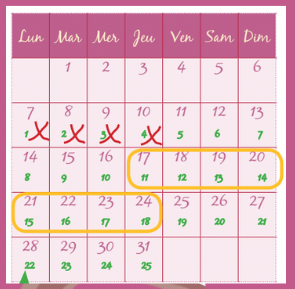The fertile period: why and how can you detect it?
Ovulation and fertility: are they the same thing?
Ovulation is what happens in your lower abdomen about 14 days before your period. It’s very short (between 16 and 32 hours…), and it’s the moment when one of your two ovaries releases an egg, called the ovum. Depending on the woman and her cycle, ovulation may not occur.
Every month, for a few days around ovulation, a woman is fertile. This means that a pregnancy can begin in her body if she has had sexual intercourse. However, just because you can get pregnant doesn’t mean that your body is capable of supporting a pregnancy. Pregnancy in young girls is dangerous for their health. Ideally, you should wait until you are at least 20.
The fertile period lasts around 7 days and begins a few days before ovulation, during phase 2 of your cycle (the pre-ovulatory phase).
Throughout this period, you can become pregnant if you have sexual intercourse with a man without contraception.
If you do, the egg that your body has released will merge with a sperm cell to form an embryo: this is fertilisation, and the start of a pregnancy.
If you do not have sexual intercourse during your fertile period, the egg decomposes and is expelled during your period, 14 days later.
How do you recognise your fertile period?
Your fertile period begins a little before ovulation and ends a little after.
Between the start of your period and the day before you ovulate, your body temperature is above 37°C. When you ovulate, your body temperature drops by at least 0.5°C.
Some girls experience a slight stomach ache during ovulation.
Your vaginal discharge (cervical mucus) changes. It becomes sticky, abundant and transparent, whereas it is usually opaque and dark.
Ovulation usually occurs 14 days before your period. If you follow your cycle in a notebook or WeerWi and observe your body, you can easily predict the next ovulation.
To find out exactly when you’re ovulating, you can :
use the WeerWi calendar to track your cycle and find out how far along you are;
monitor your temperature: every morning at the same time and before you get up. To be on the safe side, it’s best to combine this technique with another, such as observing your cervical mucus.
Observe your cervical mucus (vaginal discharge). During the fertile period it changes appearance and becomes sticky, abundant, transparent and stringy.
There are several ways to avoid getting pregnant:
Don’t have sex ;
Use contraception (pill, implant, IUD, etc.). In this case, consult a doctor, midwife or gynaecologist;
Ask your partner to use a condom during sex;
Avoid sexual relations during your fertile period. Be careful with this method, as accidents can happen.
If you think you might be pregnant, go to a chemist and get a pregnancy test and see a midwife.
When you reach menopause age (usually around 45 to 50), your menstrual cycle will stop: you will no longer ovulate, you will no longer menstruate and you will no longer be able to have children.
The good news!
The fertile phase is generally a phase of the cycle when you’re feeling great: you’re communicating, you’re enjoying yourself and you’ve got lots of energy.
Make the most of it and get your projects off the ground!
Source: Toubibadakar



